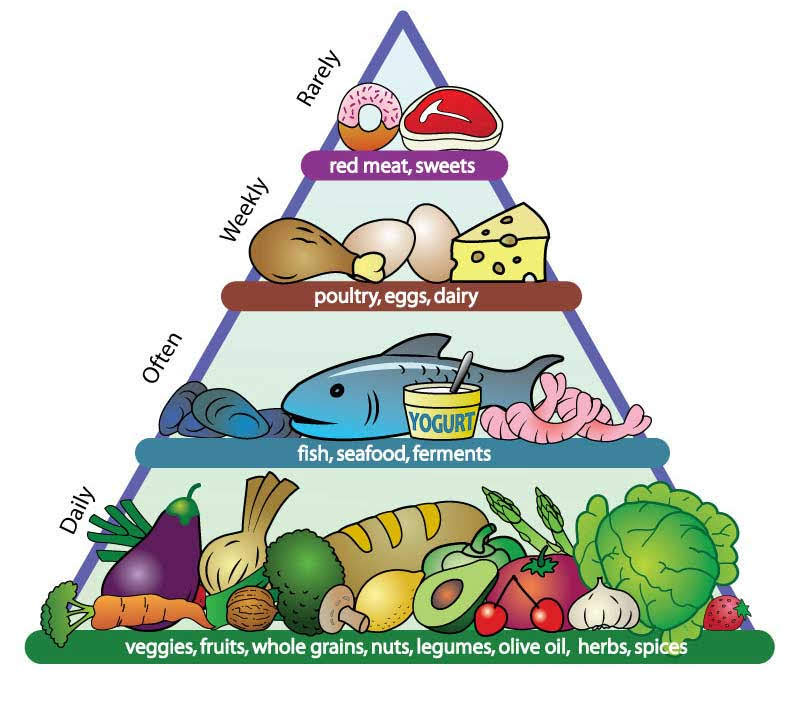How to Eat Yourself Happy
Introducing a new food pyramid for a better mood.
Your body is not a temple. It’s an amusement park. Enjoy the ride. – Anthony Bourdain
Last week we explored the dark side of the processed food industry. Sadly, food manufacturers have taken us down the road of cheap and tasty, instead of good and healthy. After 70 years of this, two thirds of us are overweight or obese, diabetes is on a rampage and depression is the number one cause of disability. So, what can we do about it?
Be nice to your gut microbes
It’s all about your gut microbes, so step number one is modifying your diet to support the good ones. Beneficial microbes create substances that both nourish and heal your gut lining, preventing infection by disease-causing bacteria. That in turn helps to lower chronic systemic inflammation, the root cause of most sickness. For your mental health, you need to support your psychobiotic microbes, the ones that can improve your mood. Here is a food pyramid that shows what you should be eating to support the good guys:
The Psychobiotic Food Pyramid. Copyright © 2022 by Scott C. Anderson.
The foods at the bottom are the ones to concentrate on. This is a lot like the Mediterranean diet, heavy on the fiber-filled veggies that microbes love. Aim for colorful veggies and berries that contain polyphenols and flavonoids. These have antioxidant properties and are like ambrosia for your beneficial microbes.
The next step up includes seafood to add healthy omega-3 oils to your diet, as well as ferments which contain live bacteria. Vegans can substitute seaweed and krauts for a similar impact.
The next step introduces dairy, eggs and poultry. These can be consumed weekly to provide high levels of good protein. Vegan sources of protein include beans, quinoa, nuts and lentils, but because their protein levels are comparatively lower, they should be consumed more often.
The items at the top are to be eaten rarely, if at all. Sweets are bad for your microbiota, and despite what fast-food commercials tell you, we don’t need red meat every day. Processed meats like sausage and hot dogs are even more problematic, depending on additives like preservatives, hormones, and colorants. This is hard for Americans, who are big red-meat eaters, but if you moderate your consumption, your plant-loving microbes will thank you.
A deeper dive
Going deeper into the psychobiotic food pyramid, here are some more tips to grow a healthy set of gut microbes.
Stop eating so much sugar. Sugary foods feed pathogenic bacteria. Sugar is added to so many processed foods, it can be hard to escape. So check those labels. Better yet, cook your own food so you know what you're eating.
Eat high-fiber veggies. These include foods like asparagus, leeks, artichokes, and garlic. The fiber in these foods will pass through your small intestines intact and make it to the colon to feed your healthy microbes. Grains are great if they are whole grains and you can tolerate them. But refined grains are not much better than sugar.
Eat fermented foods. This is a great way to add some good bacteria to your diet. Most of these microbes will not stick around in your gut, but they will alter the environment for the better as they pass through. That means you should make this a regular routine. Excellent choices: yogurt, kefir, kombucha, kimchi, and kraut.
Eat a little fish. Omega-3 oils, found in fish like salmon, reduce inflammation and keep your body from going overboard and attacking your own tissues. If you're a vegetarian or vegan, look to foods like walnuts to get your omega-3s.
Try prebiotics. If you can't get enough fiber from veggies, try topping off with prebiotic supplements. These are complex sugars called oligosaccharides (OS) in various flavors like GOS, FOS, XOS, and others. For mood, FOS and GOS have shown the best results. Also in this group is resistant starch. Weird tip: You can convert ordinary carbs to resistant starch by cooling them. Thus, cold potato salad is healthier for you than a hot potato.
Although we don't know exactly why, exercise also helps your gut microbes. If you can follow these tips, your gut can change quickly: In as little as a week or two, you should notice an improvement.
It won't just be a better mood; you will radiate a healthy glow as your entire body recovers from the effects of processed foods. Give it a try! It can put a long-lasting smile on your face.
References
Dinan, Timothy G., Catherine Stanton, Caitriona Long-Smith, Paul Kennedy, John F. Cryan, Caitlin S. M. Cowan, María Carmen Cenit, Jan-Willem van der Kamp, and Yolanda Sanz. “Feeding Melancholic Microbes: MyNewGut Recommendations on Diet and Mood.” Clinical Nutrition (Edinburgh, Scotland), November 17, 2018.
Lassale, Camille, G. David Batty, Amaria Baghdadli, Felice Jacka, Almudena Sánchez-Villegas, Mika Kivimäki, and Tasnime Akbaraly. “Healthy Dietary Indices and Risk of Depressive Outcomes: A Systematic Review and Meta-Analysis of Observational Studies.” Molecular Psychiatry 24, no. 7 (July 2019): 965–86.


